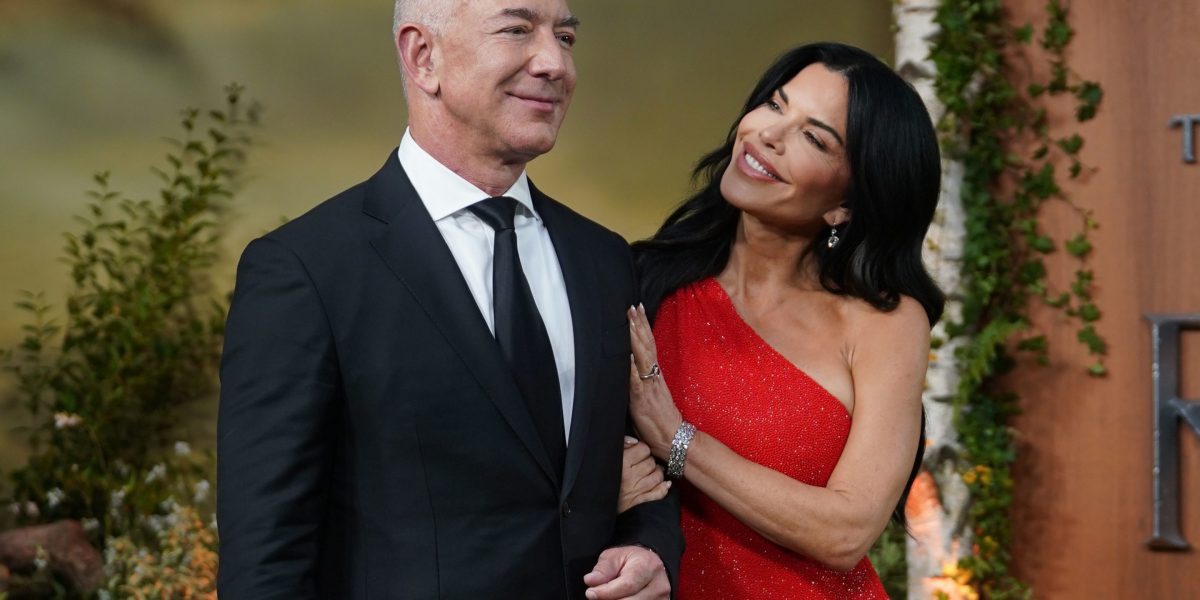After stepping out of her personal helicopter, wrapping up a 400,000-acre aerial tour of the Blue Origin base and expansive multimillion-dollar ranch combo that Lauren Sánchez shares with her billionaire fiancé Jeff Bezos, Sánchez went on to tell a Vogue reporter about what a regular person she is. “Our lives are pretty normal,” Sánchez says, adding that “daily life mostly revolves around our kids.”
The couples’ day starts with whoever wakes up first making the other a cup of coffee (Bezos takes his black, or with his favorite dairy creamer, made by surfer Laird Hamilton), according to Sánchez. Sometimes Sánchez makes fried eggs on flour tortillas for breakfast. Sometimes, Bezos breaks out the deep fryer on the weekends to make churros.
The couple reports to work out regularly together, ending the day at an early 9:30 pm by watching some TV. The couple has a very suburban-sounding tradition of Saturday family movie nights. In between piano lessons, dropping off and picking up the kids, there’s family dinner “every night.”
The Sánchez-Bezos weekday runs around their kids, per their account to Vogue. Flitting between where the youngest kids are based (in LA) to the Lake Washington estate, and university visits for the adult children in between, the couple also claims to have an established drop-off routine that involves Sánchez personally driving her kid to school.
Describing morning coffee, school drop-offs, and evening television, Sánchez and Bezos sound like any ole middle-class family. But he is, of course, one of the richest men in the history of the world, and what the piece excludes reveals much of America’s current struggle with inequality—and what the ultra-rich don’t want to admit to themselves.
The internet cannot get enough of this particular framing, as a viral tweet of one of the Vogue photoshoots where Sánchez and Bezos wear simple jeans and a cowboy hat puts it:“America is amazing. A man who was once the richest person alive still feels the urge to cosplay as a working class stiff.”
Massive ranch and staff on payroll
After exiting her Bell 429 helicopter, Sánchez gave Vogue an aerial tour of the couple’s ranch in Texas. The value of this ranch is undisclosed, but The Wall Street Journal reported in 2019 that it encompasses 30,000 acres and was purchased because Bezos was nostalgic for the 25,000-acre ranch in the Lone Star state owned by his grandfather.
To say it’s one of several homes that Bezos owns is also an understatement. The billionaire, who stands as the second-richest person in the world with a net worth of more than $166 billion, owned 420,000 acres as of 2022, making him the 24th largest landowner in the nation, per Hayden Outdoors’ 2022 Land Report,
Consider how they drop off the kids, too. It has a carbon footprint typical of the ultrawealthy, including a chartered bimonthly flight from LA to Lake Washington. And their homes are well-staffed. Bezos and Sánchez do pay people to help maintain their house, one of whom, Mercedes Wedaa, made headlines last year as she sued the mogul for racial discrimination and being forced to work long shifts in poor conditions without rests or meal breaks.
Death of American Dream fuels backlash
In reality, the Amazon founder isn’t the only American billionaire doing his best version of “Stars—They’re just like us!” The long pastime of underplaying wealth is baked into our nation and it’s recently gained the nickname “quiet luxury.”
It’s a tactic to seem humble, despite the inside of a pocketbook that would suggest otherwise. “Theodore Roosevelt said: ‘Speak softly and carry a big stick.’ The ultra-high-net-worth corollary to this would be ‘Don’t be flashy, and keep your wealth out of view,” David Sadkin, president of Los Angeles–based Bel Air Investment Advisors, told Fortune, adding that many clients engage in said behavior as to also avoid uncomfortable expectations from others.
And this type of wolf in discount sheep’s clothing behavior might be getting a bit more popular as wealth inequality spikes and resentment towards billionaires grows. The ultrawealthy found extra riches during the pandemic, as a report from nonprofit Oxfam found that the wealth of the top 1% increased nearly twice as much as the rest of the world over that stretch. Meanwhile, the average American has run into a high cost of living, impenetrable housing market, and massive student loans.
Decades-long issues of wealth disparity become clearer as a fraction of a billionaire’s net worth could alleviate many of the most pressing global issues. Just 1.9% of Bezos’ worth could fund a year of Pre-K for every child in the U.S., points out Mona Chalabi for the New York Times. As the rich continue to win out both in terms of salary and relatively lenient tax breaks, opinion on our billionaires has started to sour. Americans have started to become less positive about billionaires since the pandemic began, as the number of those who say billionaires are bad for the nation has increased from 23% in 2020 to 29% in 2021 per Pew Research Center.
Younger generations are more likely to report feelings of resentment towards the wealthy, according to Cato 2019 Welfare, Work, and Wealth National Survey. It makes sense given that these generations have faced a more uphill battle to wealth building, fearing for their financial future as they grow up to find the ending of the American Dream that boomers once spoke of. While it likely never existed, life is certainly harder for millennials and Gen Zers who can often only afford a house when older generations chip in, and even then are finding themselves outbid.
It’s all enough to make the majority (69%) of Americans think that the economy is rigged to help out the rich and powerful, per an Ipsos Poll. Perhaps that’s why Bezos and Sánchez insist that really, they are just like the rest of us. But it’s all, a little rich, and most Americans aren’t buying the billionaire’’s act.





